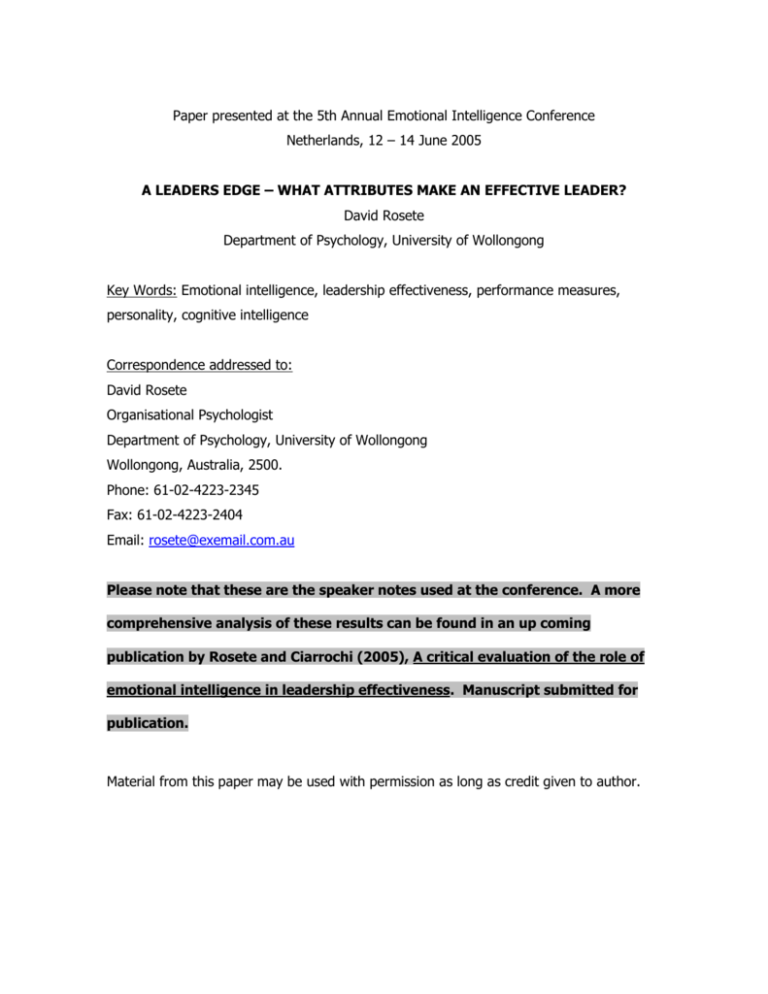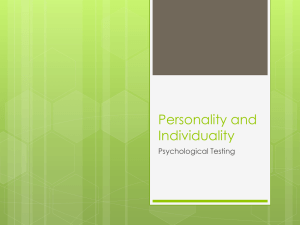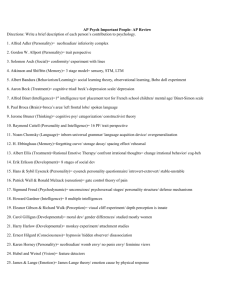Paper accepted for presentation at the 5th Annual Emotional
advertisement

Paper presented at the 5th Annual Emotional Intelligence Conference Netherlands, 12 – 14 June 2005 A LEADERS EDGE – WHAT ATTRIBUTES MAKE AN EFFECTIVE LEADER? David Rosete Department of Psychology, University of Wollongong Key Words: Emotional intelligence, leadership effectiveness, performance measures, personality, cognitive intelligence Correspondence addressed to: David Rosete Organisational Psychologist Department of Psychology, University of Wollongong Wollongong, Australia, 2500. Phone: 61-02-4223-2345 Fax: 61-02-4223-2404 Email: rosete@exemail.com.au Please note that these are the speaker notes used at the conference. A more comprehensive analysis of these results can be found in an up coming publication by Rosete and Ciarrochi (2005), A critical evaluation of the role of emotional intelligence in leadership effectiveness. Manuscript submitted for publication. Material from this paper may be used with permission as long as credit given to author. INTRODUCTION Are good leaders more emotionally intelligent? One area gaining extraordinary interest in both the media and academic research and appearing to be important in the study of leadership is the field of emotional intelligence (EI). The EI concept itself is being touted as the next panacea for identifying and developing future effective leaders. Some prominent EI advocates suggest that EI is the crucial difference between an average leader and effective leader with close to 90 percent of an effective leader success being attributable to EI (Goleman, 1998). While no study to date has been able to demonstrate that EI can be attributed to 90 percent of effective leadership, the cumulative research on EI does show every indication that it can be predictive of performance and is in fact a construct worthy of research with the field of leadership (Rooy & Viswesvaran, 2003). While there has been speculation regarding the relationship between EI and leadership effectiveness, this has generally not been based upon empirical research and has failed to accurately measure effective leadership. The transformational/transactional leadership model of Bass and Avolio (1995) has provided the general framework for most of the assertions made about the link between emotional intelligence and leadership effectiveness. While research based on self-reported managerial style is important, research is still needed to evaluate whether an ability-based test of EI or self-report measure of EI is related to relatively objective (or non-self-report) measures of leadership effectiveness such as supervisor ratings or measures of actual business unit performance. Lopes, Côté, Grewal, Kadis, Gall and Salovey (2003) research Examined the link between an ability measure of EI (MSCEIT) and several indicators of job performance, including salary, merit increases, and company rank. They also assessed interpersonal facilitation, affect and attitudes at work, and leadership potential, using both peer and supervisor ratings in 44 analysts and clerical/administrative employees from finance area within a Fortune 400 insurance company. The findings revealed that EI was related to the percentage of pay increase a supervisor would obtain 2 and their internal classification level. In addition, those analysts receiving better peer and supervisor ratings also held higher EI scores. Importantly, these results held even after controlling for the effects of cognitive ability and personality traits. Rosete and Ciarrochi (in press) research Investigated the relationship between an ability measure of emotional intelligence (MSCEIT), personality, cognitive intelligence and leadership effectiveness with senior executives (N = 41) of a large public service organisation. Leadership effectiveness was assessed using managerial performance ratings and a 360 assessment involving each leader’s subordinates and direct manager ratings. Correlational analyses revealed that higher emotional intelligence was associated with higher leadership effectiveness, and that EI explained variance not explained by either personality or IQ. Present Study and Hypotheses This study sought to address two major questions. First, to what extent is selfreported and performance based measures of EI related to leadership performance? Second, to what extent do the EI measures predict variance in performance over and above that accounted for by traditional personality and reasoning measures? 3 METHOD Participants The initial sample consisted of 122 executives from a large Australian Public Service organisation. Executives who did not complete the main battery of measures or whose performance ratings were not accessible were then excluded leaving a final sample of 117 executives. The main sample also consisted of both assistant directors (n = 64) and directors (n = 52) with 1 unreported. Fifty six (48.28%) of respondents were male, and 60 (51.72%) female with 1 unreported. Participant ages ranged from 27 – 60 years, and the average age was 40.54 years (S.D. = 8.95). The mean tenure within the organisation was approximately 15 years. The level of qualifications amongst the sample was quite impressive with approximately 32% reported to have completed a masters degree or higher; 22% reported to have completed a postgraduate diploma or certificate; 33% reported to have completed an undergraduate degree and 4% reported to have completed some form of associate diploma or certificate. The sample well represents the Australian Public Service (APS) in terms of age and gender with a State of the Service report by the Australian Public Service Commission (2004) showing that the average age across all APS organisations is 41 years, with females representing 53% of the workforce. Procedure Participants were administered a battery of psychological tests (i.e., 16PF, MSCEIT, and SUEIT). All participants were provided with information regarding the instruments, consent forms, a copy of the 16PF, and a copy of the SUEIT. In exchange for their participation, individuals were provided with a confidential feedback report on their results on each of the instruments. 4 Materials Emotional Intelligence via the MSCEIT Mayer-Salovey-Caruso Emotional Intelligence Test (MSCEIT © 2002, Multi-Health Systems Inc) - It contains 141 items which are broken down into eight tasks, which are further divided into four branches of abilities including (a) perceiving emotion, (b) using emotion to facilitate thought, (c) understanding emotion, and (d) managing emotions. The coefficient alphas were perceiving emotion (r = .76); using emotion to facilitate thought (r = .70); understanding emotion (r = .78); managing emotion (r = .75) and an overall reliability of r = .67. MSCEIT TOTAL EXPERIENTIAL STRATEGIC Perceiving Facilitating Understanding Managing Faces Sensations Blends Emotion Management Pictures Facilitation Changes Emotional Relations Emotional Intelligence via the SUEIT The SUEIT is a self-report measure consisting of 65 items. Each item asks participants to indicate the extent to which a particular statement is true of the way they typically think, feel and act at work (on a five-point scale: 1 = never, 2 = seldom, 3 = sometimes, 4 = usually, 5 = always). The SUEIT report provides an overall EI score that indicates a participant’s general workplace EI, and five sub-scale scores including (1) emotional recognition and expression (in oneself); (2) emotions direct cognition; (3) understanding of emotions external; (4) emotional management; and (5) emotional control. The coefficient alphas for the five sub-scales were: ER&C (r = .74); EDC (r = .78); UEE (r = .69); EM (r = .73) and EC (r = .76) with an overall reliability of r = .72 for the SUEIT EI. 5 The SUEIT was developed after an extensive factor analytic study involving five of the predominant measures of EI. Four of these were other self-report measures of EI including: Bar-On Emotional Quotient Inventory (Bar-On, 1997) Trait Meta-Mood Scale (Salovey et al., 1995) Toronto Alexithymia Scale-II (TAS-20, Taylor 2000) Emotional Intelligence Scale (Schutte, Malouff, Hall, Haggerty, Cooper, Golden and Dornhein, 1997) Measuring Personality via the 16PF 16PF5 185 items. 16 Primary personality factors. Impression Management (IM) index. Each scale contains 10 to 15 items. Administered individually or in a group by hand (35 – 50 minutes) or by computer (25 – 35 minutes) Readability is at the fifth-grade level. Measuring Cognitive Ability via Factor B Reasoning Factor B - Reasoning scale measures three areas of general reasoning ability, verbal, numerical, and logical reasoning in a 15-item scale. The scale has an overall coefficient alpha of .80 and has been shown to correlate with other general ability measures such as the Information Inventory (r = .61) and the Culture Fair Intelligence Test (r = .51). The scale itself was included in the personality measure as it is considered that reasoning ability is an important dimension of individual differences in personality. Measuring Leadership Effectiveness – Annual Appraisal The annual appraisal is a formal feedback discussion between a manager and an executive about work performance. The purpose of the annual appraisal is to review an 6 executive’s performance against their business plans, sometimes referred to as performance and development agreement (PDA). There are two focuses placed on the annual appraisal: (1) “What” has been achieved, and (2) “How” has it been achieved. Examples of the “What” focus include whether occupational health premiums been decreased, whether external charter standards been met, whether the specific area has delivered on key government initiatives, or whether tax revenue targets been achieved. The what section is always expressed in terms of both deliverable and measurable objectives. While this section of the PDA is highly individualistic, the intent is always the same, namely, to establish if the executive officer is achieving organisational goals and objectives. The how focus of the PDA is on how the work and leadership behaviours were adopted to achieve business outputs. A significant part of the how aspect is an individual’s ability to demonstrate core leadership behaviours as outlined by the Australian Public Service Commission (APSC) Leadership Capability Framework (see figure 1). Figure 1: APSC Leadership Framework 7 These performance appraisal elements are aligned with best practice literature. The Corporate Leadership Council (CLC - 2002) conducted a quantitative survey of 19,000 individuals at 34 organisations and identified seven key insights regarding drivers of individual performance – the performance management system being one of them. They found that the impact of performance management levers was remarkably consistent across different segments of the workforce, including geographical region, company, level, function, performance level and demographic characteristics. In preparing a best practice guide in performance management the Corporate Leadership Council highlighted that for a performance appraisal process to be effective, organisations must involve line managers as champions of performance management activities, must hold managers accountable for performance improvement, and support manager with multiple perspectives on performance. These elements were present in the current performance appraisal system (refer to figure 2). Review evidence Independently collect and evidence Manager PDA Discussion Specific targets been met? Independently collect and evidence Review original objectives & outcomes Executive Officer Feedback to the Executive Officer Review executive behaviours against leadership framework Review any learning & development plans Performance ratings What & How Final Ratings Corporate Assurance Committee Departments Performance Assurance Committee Manager Employee Agree on interim ratings Figure 2: Overview of the Performance Management System 8 An important point to note is that both “what” and “how” ratings are equally important in determining overall performance. They are based on the highly structured assessment of the evidence the manager has gathered regarding the executive officers’ performance and information gained during the appraisal discussion. Consistent with the validity of this rating procedure, the “what” and “how” ratings have been shown to correlate significantly with internal peer 360 performance ratings, r = .52 (Rosete 2004). In addition, past research has supported the validity of this sort of rating system (McEvoy and Beatty, 1989; Hogan, Curphy and Hogan, 1994; Management Advisory Committee 2001; Corporate Leadership Council, 2002). For example, McEvoy and Beatty (1989) examined the predictive validity of performance evaluations with assessment centre ratings and concluded that performance ratings were as effective as assessment centre data in forecasting performance seven years later. This suggests that business success is directly related to employee performance and the performance appraisal process is one tool used to review an executive’s performance and hence their leadership effectiveness. RESULTS Leadership effectiveness – Reasoning There were no significant correlations between Reasoning and performance ratings. Leadership effectiveness – Self report measures of EI No significant correlations were found between total SUEIT EI scores and any of the performance management measures (p > 0.05). Only the sub-branch factors of emotional management (r = .22, p < .05) and emotional control (r = .20, p < .05) correlated with one aspect of the performance rating, namely the “how” rating. These results support the first premise of H2, in that the some aspects of the SUEIT where found to correlated significantly with aspects of the performance management ratings. 9 Leadership effectiveness – Ability measures of EI Results showed a relationship between the total emotional intelligence score (M = 96.77) and performance rating on the ‘what’ scale (M = 3.36) existed (r (116) = 0.26, p < .05) and on the ‘how’ scale (M = 3.44) existed (r (116) = 0.5, p < .01). Thus, consistent with our first hypothesis, ability based measures of emotional intelligence are related to a leader’s effectiveness in being able to achieve organisational goals through obtaining higher performance ratings. 0.5 0.45 0.4 0.35 0.3 0.25 0.2 0.15 0.1 0.05 0 Reasoning SUEIT EI MSCEIT** What How 10 Leadership effectiveness – Personality There were no significant correlations between the five global factors and performance ratings. At the primary factor subscales there were some correlations. In particular, low levels of vigilance (r = 0.21, p < .05), high levels of abstractedness (r = 0.22, p < .05), low levels of privateness (r = 0.18, p < .05), and high levels of openness to change (r = 0.25, p < .05) with higher “what” performance ratings. Low levels of vigilance (r = 0.18, p < .01) were also associate with high “how” performance ratings. 0.15 0.1 0.05 Extraversion Anxiety Tough Mindedness Independence Self Control 0 -0.05 -0.1 -0.15 -0.2 What How 11 Correlations Coefficients between the MSCEIT Branch Scores with Performance Management Ratings 0.5 0.45 0.4 0.35 0.3 0.25 0.2 0.15 0.1 0.05 0 Perceiving Emotion Using Emotion Understanding Emotion Managing Emotion What How 12 Predicting Leadership Effectiveness The first set of analysis examined the what performance measure. The reasoning ability score produced a multiple R .01, did not account for any of the variance, and was not statistically significant (p > .05). When the five global personality factors of the 16PF were added in model 2, the multiple correlation was .29 and was also statistically not significant (p > .05). The third level of analysis consisted of the MSCEIT EI score was added on model 3A and produced a multiple R. 37 accounting for approximately 5% of the variance in the what perspective of the performance management system. The ability measure of EI was able to explain an additional 5% of the variance above both cognitive ability and personality characteristics and was found to be significant. Finally, when the SUEIT EI score was introduced it produced no change in the multiple correlation and accounted for no change in the variance, model 3B. The self-report EI measure did not increase the amount of variance in the model. In terms of the how performance measure, the reasoning ability score produced a multiple R .12 and was not statistically significant (p > .05). When the five global personality factors of the 16PF were added in model 2, the multiple correlation was .25 and again was not statistically significant (p > .05). The third level of analysis consisted of the MSCEIT EI score which was added on model 3A and produced a multiple R. 53 accounting for approximately 22% of the variance in the how perspective of the performance management system. The ability measure of EI was able to explain an additional 22% of the variance above both cognitive ability and personality characteristics. The last model (3B) includes the SUEIT EI score which produced a multiple correlation of .30, and was also found to be not statistically significant. 13 The relationship between EI and performance when controlling for personality and cognitive ability Model R R2 Std. Error of R2 the Estimate Change “What” Performance Measure Model 1 - Cognitive Ability .01 .00 .52 .00 Model 2 - Cognitive Ability, Personality (Big Five) .29 .08 .51 .08 Model 3A - Cognitive Ability, Personality (Big Five), Ability Measure of EI .37 .13 .50 .05** Model 3B - Cognitive Ability, Personality (Big Five), Self Report Measure of EI .31 .10 .51 .00 Model 1 - Cognitive Ability .12 .02 .51 .02 Model 2 - Cognitive Ability, Personality (Big Five) .25 .06 .51 .05 Model 3A - Cognitive Ability, Personality (Big Five), Ability Measure of EI .53 .28 .45 .22** Model 3B - Cognitive Ability, Personality (Big Five), Self Report Measure of EI .30 .09 .51 .01 “How” Performance Measure ** p < .01 14 REFERENCES Avolio, B. J., B. M. Bass, et al. (1999). Re-examining the components of transformational and transactional leadership using the multifactor leadership questionnaire. Journal of Occupational and Organizational Psychology 72(4): 441-463. Bar-On, R. (1997), Bar-On Emotional Quotient Inventory: User’s Manual, Multi-Health Systems, New York, NY. Corporate Leadership Council (2002). Closing the Performance Gap: Driving Business Results Through Performance Management. Corporate Executive Board, Washington. Goleman, D. (1998), Working with Emotional Intelligence, Bloomsbury Publishing, London. Hogan, R., G. Curphy, Hogan. (1994). What we know about leadership: Effectiveness and personality. American Psychologist 49(6): 493-504. Lopes, Côté, Grewal, Kadis, Gall and Salovey (2003). Evidence that Emotional Intelligence is Related to Job Performance, Interpersonal Facilitation, Affect and Attitudes at Work, and Leadership Potential. Manuscript submit for publication. Management Advisory Committee. (2001). Performance Management in the Australian Public Service. Canberra, Commonwealth of Australia. McEvoy, G.M., and Beatty, R.W. (1989). Assessment centers and subordinate appraisals of managers. Personnel Psychology, 42(1), p 37. Mayer, J.D., Salovey, P. and Caruso, D.R. (2002), Mayer-Salovey-Caruso Emotional Intelligence Test, Multi-Health Systems, Toronto. Rooy, D. L. V. and C. Viswesvaran (2003). Emotional intelligence: A meta-analytic investigation of predictive validity and nomological net. Journal of Vocational Behavior. 15 Rosete, D. (2004). A Leaders profile - What attributes make an effective leader? 4th International Test Users' Conference, Melbourne. Rosete, D. and J. Ciarrochi (in press). Emotional intelligence and its relationship to workplace performance outcomes of leadership effectiveness. Leadership and Organization Development Journal. Salovey, P., Mayer, J., Goldman, S., Turvey, C. & Palfai, T. (1995). Emotional attention, clarity and repair: Exploring emotional intelligence using the Trait Meta-Mood Scale. In J.W. Pennebaker, Emotion, disclosure, and health (pp. 125-154) Washington, DC: American Psychological Association. Schutte, N. S., J. M. Malouff, Hall, Haggerty, Cooper, Golden and Dornhein, (1997). Development and validation of a measure of emotional intelligence. Personality and Individual Differences 25: 167-177. Taylor, G. J. (2000). Recent developments in alexithymia theory and research. Canada Journal Psychiatry 45: 134-142. 16







